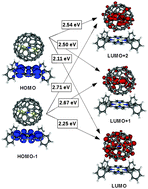The electronic structure and charge transfer excited states of the endohedral trimetallic nitride C80 (Ih) fullerenes–Zn-tetraphenyl porphyrin dyads†
Abstract
Endohedral fullerenes offer the possibility of tuning their properties through a choice of the endohedral unit. The Sc3N@C80 fullerene is the most abundant fullerene after C60 and C70. Recently, Sc3N@C80 has been tested for light harvesting properties with encouraging results. In this work, we study the electronic structure of three endohedral fullerene–Zn tetraphenyl porphyrin complexes using density functional theory. The binding between the components in these complexes arises due to van der Waals interaction. A fragment orbital analysis is carried out to examine the interaction between the two components which shows that a small charge transfer occurs in the ground state from the ZnTPP to the fullerenes and that the orientation of the Sc3N plane affects the ground state charge transfer. The charge transfer excited state energies are calculated using our perturbative delta-SCF method. A comparison with earlier calculations shows that the charge transfer excitation energy increases as C60–ZnTPP < C70–ZnTPP < Sc3N@C80–ZnTPP < Y3N@C80–ZnTPP. The orientation of the endohedral unit does not influence the excitation energy in the donor–acceptor complexes.


 Please wait while we load your content...
Please wait while we load your content...